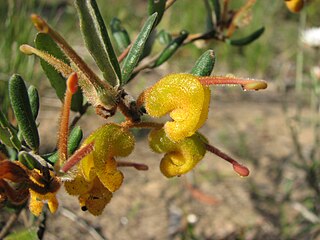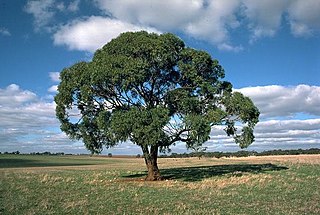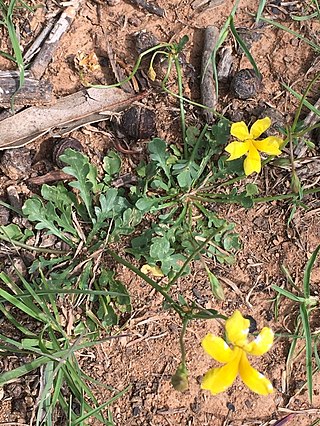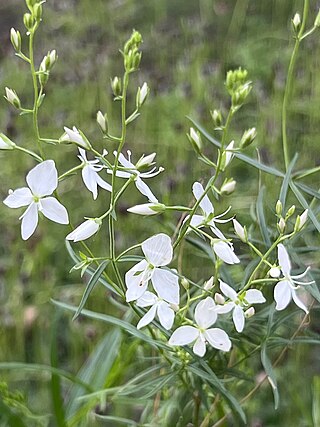
Grevillea chrysophaea, commonly known as golden grevillea, is a species of flowering plant in the family Proteaceae and is endemic to Victoria in Australia. It is a spreading shrub with oblong to almost linear leaves, and dull to golden yellow flowers with a red or orange-red style.

Diuris behrii, commonly known as golden cowslips, is a species of orchid which is endemic to eastern Australia. It occurs in South Australia, Victoria, New South Wales and the Australian Capital Territory. It has between three and six grass-like leaves and a flowering stem with up to four drooping, yellow flowers with dark streaks on the labellum. The flowers appear between September and November in its native range.

Eucalyptus odorata, commonly known as peppermint box, is a species of mallee or a small tree that is endemic to South Australia. It has rough, hard bark on the trunk and larger branches, smooth greyish bark on the thinner branches, lance-shaped adult leaves, flower buds in groups of between seven and eleven, white flowers and cylindrical or barrel-shaped fruit.

Grevillea micrantha, also known as small-flower grevillea, is a species of flowering plant in the family Proteaceae and is endemic to Victoria in Australia. It is a spreading shrub with linear leaves and clusters of white to pale pink flowers.

Leptospermum myrsinoides, commonly known as the heath tea-tree or silky tea-tree, is a species of shrub that is endemic to south-eastern continental Australia. It has smooth bark on the younger stems, narrow egg-shaped leaves with the narrower end towards the base, white flowers and fruit that has the remains of the sepals attached but usually falls from the plant soon after the seeds are released.

Prostanthera striatiflora, commonly known as jockey's cap, striated mintbush or striped mintbush, is a species of flowering plant that is endemic to the more arid areas of Australia. It is an erect, aromatic shrub with narrow egg-shaped to narrow elliptic leaves and white flowers with purple lines inside the petal tube.

Billardiera sericophora is a species of flowering plant in the family Pittosporaceae and is endemic to the south-east of South Australia. It is spreading shrub or climber that has mostly narrowly elliptic leaves and pendent yellow flowers arranged singly or in pairs.
Caladenia behrii, commonly known as pink-lipped spider orchid is a plant in the orchid family Orchidaceae and is endemic to South Australia. It has a single narrow, hairy leaf and one or two creamy-white flowers with pink tips in early spring.

Caladenia tentaculata, commonly known as the eastern mantis orchid, large green-comb, green comb or fringed spider orchid is a plant in the orchid family Orchidaceae and is endemic to south-eastern Australia. It is a ground orchid with a single, hairy leaf and up to three green flowers with red stripes on the sepals and petals.

Isotoma petraea, commonly known as rock isotome, is a small, herbaceous plant in the family Campanulaceae occurring in arid regions of Australia. It has single, purplish-blue flowers on smooth, slender branches from February to November.

Prostanthera behriana, commonly known as tall mintbush, is a species of flowering plant in the family Lamiaceae and is endemic to the south-east of South Australia. It is an erect to straggling shrub with egg-shaped leaves and white, pale blue, pale violet or purplish white flowers with red-brown spots or purple streaks inside.

Goodenia calcarata, commonly known as streaked goodenia, is a species of flowering plant in the family Goodeniaceae and is endemic to Australia. It is an erect, annual herb with toothed egg-shaped to oblong leaves, racemes of white, cream-coloured or pink to mauve flowers with brownish markings, and oval fruit.

Goodenia pinnatifida, commonly known as cut-leaf goodenia, scrambled eggs or mother ducks, is a species of flowering plant in the family Goodeniaceae and endemic to Australia. It is a low-lying to ascending perennial herb with toothed to pinnatisect leaves, racemes of yellow flowers and more or less spherical fruit.

Dampiera rosmarinifolia, commonly known as rosemary dampiera, is a flowering plant in the family Goodeniaceae.It is a perennial subshrub with linear leaves, mauve or purple flowers borne in leaf axils.

Spyridium coactilifolium, commonly known as butterfly spyridium, is a species of flowering plant in the family Rhamnaceae. It has white-velvety flowers and oval shaped leaves that are thickly covered in soft hairs.

Olearia muelleri, commonly known as Mueller daisy bush, Mueller's daisy bush or Goldfields daisy, is a species of flowering plant in the family Asteraceae and is endemic to southern continental Australia. It is a compact or spreading shrub with scattered spatula-shaped to egg-shaped leaves with the narrower end towards the base, and white and yellow, daisy-like inflorescences.
Pomaderris flabellaris, commonly known as fan pomaderris, is a species of flowering plant in the family Rhamnaceae and is endemic to South Australia. It is a low shrub with fan-shaped leaves, and small clusters of woolly-hairy flowers.

Pomaderris helianthemifolia is a species of flowering plant in the family Rhamnaceae and is endemic to south-eastern continental Australia. It is a bushy shrub with hairy young stems, narrowly elliptic to lance-shaped leaves with the narrower end towards the base, and small panicles of hairy yellowish flowers.
Olearia picridifolia, commonly known as rasp scrub-daisy, is a species of flowering plant in the family Asteraceae and is endemic to southern continental Australia. It is a low, spreading shrub with narrowly egg-shaped or narrowly elliptic leaves, and blue, mauve or white and yellow, daisy-like inflorescences.

Veronica decorosa, is a flowering plant in the family Plantaginaceae and grows in South Australia. It has white flowers borne on long stems.

















